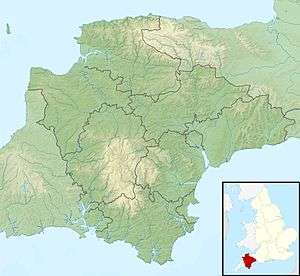Newton Abbot power station
| Jetty Marsh Power Station | |
|---|---|
 View of the Power Station taken in 1962 | |
 Location of Jetty Marsh Power Station in Devon | |
| Official name | Newton Abbot Power Station |
| Country | England |
| Location | Newton Abbot, Devon |
| Coordinates | 50°32′01″N 3°36′03″W / 50.5336°N 3.6008°WCoordinates: 50°32′01″N 3°36′03″W / 50.5336°N 3.6008°W |
| Commission date | 1898 |
| Decommission date | 1974 |
| Operator(s) | Torquay Corporation |
| Thermal power station | |
| Primary fuel | Coal |
The Newton Abbot power station was a power station originally built in 1898 at Jetty Marsh, Newton Abbot as a small station to serve the local community. It was subsequently significantly expanded, and changed from direct current to alternating current when bought by the Torquay corporation in the 1920s to provide power across a wider area towards the coast.[1]
It reached its peak capacity of 52.5 megawatts in 1948 - the same year that it was nationalised in to the South Western Electricity Board. The station was used less from the mid 1960s as more efficient plant was used via the national grid, and it was finally closed in 1974 with demolition following shortly after. The site is now the Jetty Marsh nature reserve, and a housing estate.
History
From the late 1890s, both Newton Abbot and Torquay developed their own electricity generating capacity to serve the local areas. The Newton Abbot Electricity Generating Station was established with all direct current (DC) supply, being used mainly for industrial loads.[2]
The site was located at Jetty Marsh, adjacent to the Moretonhampstead and South Devon Railway branch of the Great Western Railway, and between the River Teign and River Lemon. This allowed the station to receive coal deliveries both by rail, and by barge at the jetty. The power station also drew water from the Teign, before discharging it again in the Lemon.
In the 1920s, the Torquay Corporation acquired the Newton Abbot power station, and built a new station to replace their aging unit at Beacon Quay on Torquay seafront. The new station, serving both Newton Abbot and Torquay, was opened in 1924, and was continually expanded until the last major investment in 1948. During the development of the high pressure section of the power station in 1940 a single, large cooling tower was built to satisfy the condenser demands or the new boilers, and this was a dominant feature of the Newton Abbot Skyline.[1]
In 1948, electricity supply was nationalised, and the station became the responsibility of the South Western Electricity Board. Once connected to the national grid, it was a smaller and less efficient station, and usage gradually declined, including long periods of 'cold' shutdown.
The station was finally closed in 1974, and demolished shortly after.
A Bellis and Morcom steam generating engine was preserved and survives at Poldark Mine museum in Cornwall where it has been since 1972. Of the triple expansion type its believed to date from 1920.[3]
Installed generating capacity over time
| Year | DC Generation (kw) | AC Generation (kw) | Notes |
|---|---|---|---|
| 1898 | 120 | - | 3 x 40 kW |
| 1920 | 520 | - | +2 x 200 kW |
| 1924 | (200 SBy) | 6250 | +2x1250 Ex Torquay + 1 x 3750 kW |
| 1926 | (200 Sby) | 10000 | +1 x 3750 kW |
| 1929 | (200 SBy) | 17500 | +1 x 7500 kW |
| 1930 | (200 SBy) | 15000 | -2 x 1250 kW |
| 1931 | (200 SBy) | 22500 | +1 x 7500 kW |
| 1941 | (200 SBy) | 37500 | +1 x 15000 kW |
| 1948 | (200 SBy) | 52500 | +1 x 15000 kW |
| 1959 | (200 SBy) | 52000 | -500 kW Boilers Decommissioned |
| 1974 | 0 | 0 | Closed |
References
- 1 2 "Power house for the neighbours". Western Morning News. 2010-06-08.
- ↑ "Newton Abbot Power Station".
- ↑ Poldark Mining Ltd Wendron Forge guide book by G Watkins and S E Young 1979
